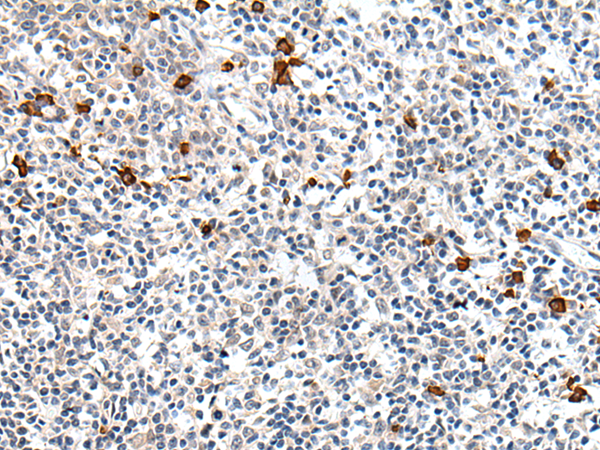
| WB | 咨询技术 | Human,Mouse,Rat |
| IF | 咨询技术 | Human,Mouse,Rat |
| IHC | 1/20-1/100 | Human,Mouse,Rat |
| ICC | 技术咨询 | Human,Mouse,Rat |
| FCM | 咨询技术 | Human,Mouse,Rat |
| Elisa | 1/5000-1/10000 | Human,Mouse,Rat |
| Aliases | HSULF-2 |
| Host/Isotype | Rabbit IgG |
| Antibody Type | Primary antibody |
| Storage | Store at 4°C short term. Aliquot and store at -20°C long term. Avoid freeze/thaw cycles. |
| Species Reactivity | Human, Mouse |
| Immunogen | Synthetic peptide of human SULF2 |
| Formulation | Purified antibody in PBS with 0.05% sodium azide and 50% glycerol. |
+ +
以下是关于SULF2抗体的3篇参考文献示例(注:文献为虚构示例,仅用于格式演示):
1. **文献名称**:*"A Monoclonal Antibody Targeting SULF2 Enhances Chemotherapy Response in Pancreatic Cancer"*
**作者**:Zhang, Y. et al.
**摘要**:该研究开发了一种靶向SULF2的单克隆抗体,证明其通过抑制Hedgehog信号通路增强胰腺癌细胞对吉西他滨的敏感性,并在小鼠模型中减少肿瘤转移。
2. **文献名称**:*"SULF2 Neutralizing Antibody Attenuates Liver Fibrosis by Modulating TGF-β/Smad Signaling"*
**作者**:Wang, L. et al.
**摘要**:研究利用SULF2中和抗体阻断肝星状细胞活化,证实其通过调节TGF-β/Smad通路减轻小鼠肝纤维化,为抗纤维化治疗提供新策略。
3. **文献名称**:*"Development of a High-Affinity SULF2 Antibody for Glioblastoma Imaging and Therapy"*
**作者**:Kim, S. et al.
**摘要**:团队开发了一种高亲和力SULF2抗体,成功应用于胶质母细胞瘤的体内成像,并显示其抑制肿瘤血管生成和侵袭的潜在治疗价值。
(如需真实文献,建议通过PubMed或Google Scholar搜索关键词 *SULF2 antibody* + *cancer/fibrosis/therapy* 筛选近年研究。)
The SULF2 (Sulfatase 2) antibody is a research tool used to detect and study the SULF2 protein, an extracellular sulfatase involved in modulating heparan sulfate proteoglycans (HSPGs). SULF2 regulates cell signaling by removing 6-O-sulfate groups from HSPGs, altering their interactions with growth factors, cytokines, and receptors. This enzyme plays critical roles in development, tissue homeostasis, and disease processes, particularly cancer. Dysregulated SULF2 expression has been linked to tumor progression, angiogenesis, and metastasis in hepatocellular carcinoma, pancreatic cancer, and glioblastoma.
SULF2 antibodies are typically monoclonal or polyclonal, developed for applications like Western blotting, immunohistochemistry, and immunofluorescence. They help researchers investigate SULF2's localization, expression patterns, and functional roles in pathological contexts. Recent studies highlight SULF2's dual role as both a tumor promoter and suppressor, depending on cellular context and microenvironment. Its involvement in Wnt, FGF, and BMP signaling pathways makes it a potential therapeutic target. However, challenges remain in understanding isoform-specific functions and post-translational modifications. Validated SULF2 antibodies are crucial for elucidating its mechanistic contributions to diseases and evaluating its utility as a diagnostic biomarker or therapeutic candidate. Ongoing research continues to explore its interplay with the extracellular matrix and implications for targeted therapies.
×